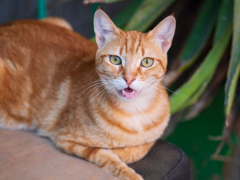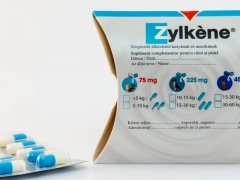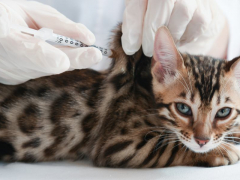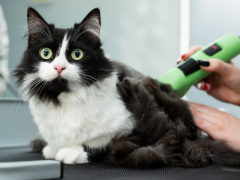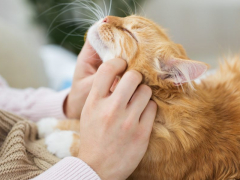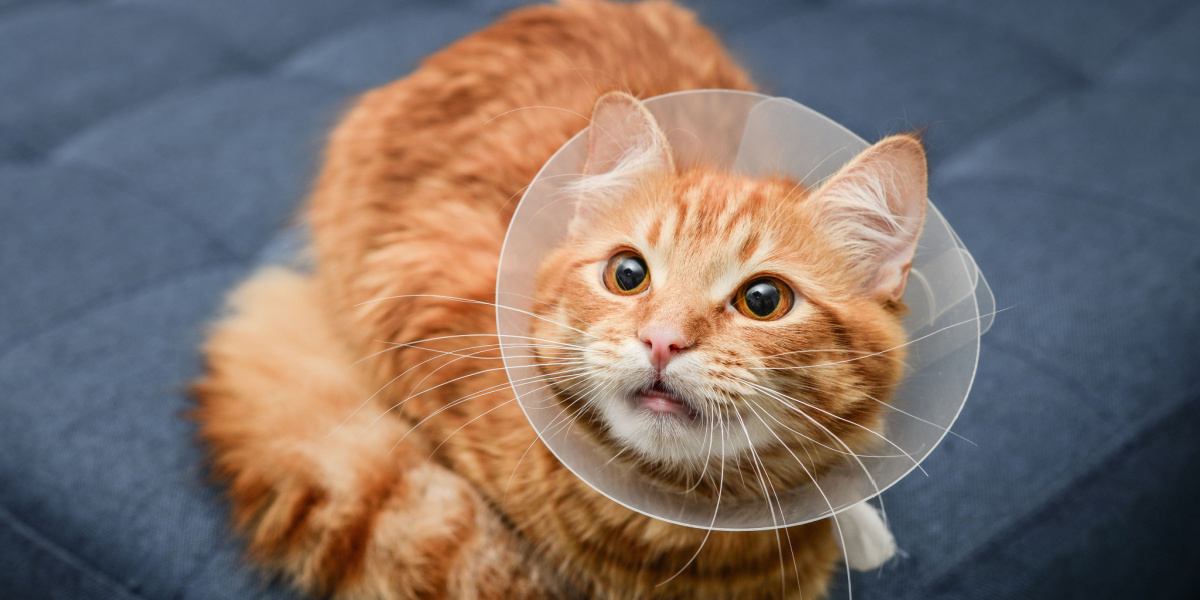
Meloxicam, brands for which include Metacam and Meloxidyl, is a nonsteroidal anti-inflammatory drug (NSAID) that may be used in cats to reduce pain and inflammation. In this article you’ll learn how meloxicam works for pain management, when it is used in cats, precautions and adverse effects, and some frequently asked questions.
Meloxicam for Cats Overview

About Meloxicam for Cats

Meloxicam is a nonsteroidal anti-inflammatory drug (NSAID) used to treat pain and inflammation in cats.
Meloxicam is a COX-2 preferential nonsteroidal anti-inflammatory drug (NSAID). The most common brand, Metacam, is manufactured by Boehringer Ingelheim.
COX stands for cyclo-oxygenase. There are two main COX pathways in the body called COX-1 and COX-2. Both pathways involve enzymes that convert a large molecule called arachidonic acid into other components that have either protective or inflammatory effects on the body.
The COX-2 pathway is one primarily of inflammation where inflammatory mediators like cytokines trigger this pathway to create further mediators that cause more pain and inflammation.
The COX-1 pathway is very different, as its pathway is responsible for protective mechanisms, especially as they relate to the protective lining of the stomach, blood flow through the kidneys, and blood clotting.
Also Read: What To Do If Your Cat Is Sneezing Blood
Some NSAIDs act to block the COX-2 pathway but at the same time also block the COX-1 pathway. This leads to reduction of inflammation, but also greatly increases risk for ulceration and bleeding in the stomach and damage to the kidneys.
But there are also COX-2 selective or preferential NSAIDs, which means while they can affect both pathways, they have a much greater predilection for blocking the COX-2 pathway of inflammation, while leaving the protective COX-1 pathway alone.
There are also COX-2 specific medications, which only act on the COX-2 pathway while leaving the COX-1 pathway alone.
Meloxicam falls within the COX-2 preferential category of NSAIDs, meaning it is not COX-2 specific. At higher doses, its focus on only the COX-2 pathway is diminished. This means that at higher doses, effects on the gastrointestinal tract, kidneys, and blood clotting mechanisms can still be affected.
Also Read: What Can You Give A Cat For Pain? 6 Vet-Recommended Options
What Does Meloxicam Do for Cats?
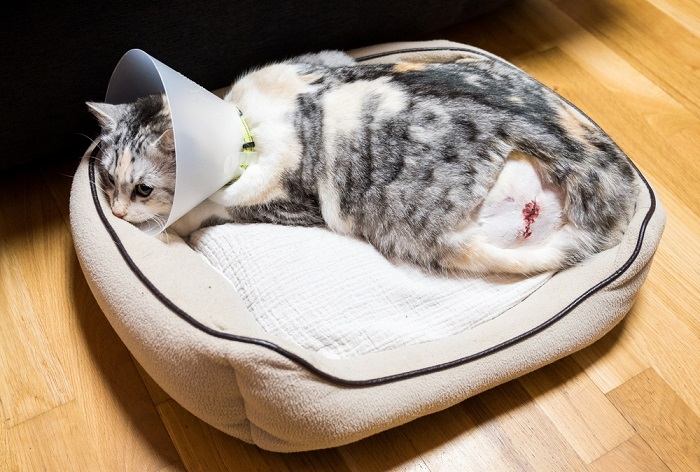
Beyond a single injectable dose for short-term pain relief, continued use of oral meloxicam is under debate.
Injectable meloxicam is FDA approved for use in the United States for short-term relief of pain and inflammation in cats, especially for post-operative pain and inflammation associated with surgeries like ovariohysterectomy (spay), castration (neuter), and orthopedic surgery.
Often, an injectable dose may be given by a veterinarian the same day as a surgical procedure or other case where pain and inflammation is present.
Also Read: How To Keep Your Cat From Jumping After Surgery
However, beyond a single injectable dose, continued use of oral meloxicam in cats is under debate. The Metacam oral suspension is only FDA approved in the U.S. for dogs, though it has been used off-label in cats for many years. In some other countries, the oral form of meloxicam is approved for use in cats.
The debate develops from the risks that meloxicam may have on the kidney function of some cats. Compared to dogs, cats appear to be much more sensitive to the COX-1 impacting effects of many NSAIDs, including meloxicam, especially if given for longer periods of time.
Guidelines for very low-dosing of meloxicam have been developed off-label for cats to use for several days. However, even at lower doses, adverse effects have been seen, especially signs of gastrointestinal illness and kidney failure.
In 2010, this prompted both the manufacturer of Metacam (Boehringer Ingelheim) and the FDA to issue a warning stating that repeated use of meloxicam in cats has been associated with acute renal failure and death. The warning further advises against additional doses of injectable or oral meloxicam in cats (beyond the single FDA-approved injectable dose).
This warning, which can be found on the drug insert for the oral Metacam suspension, is stated here:
Warning: Repeated use of meloxicam in cats has been associated with acute renal failure and death. Do not administer additional doses of injectable or oral meloxicam to cats.
However, providing some seeming contradiction to this warning, the International Society of Feline Medicine (ISFM) and the American Association of Feline Practitioners (AAFP) in their consensus guidelines on use of NSAIDs in cats published the same year (2010) contain statements supporting the promise of NSAID use in cats.
These statements include reference to published studies that, while limited in number, show some promise for the medium and long-term use of the COX-1 sparing drug meloxicam in older cats and cats with chronic kidney disease.
A summary of these statements, as provided in Plumb’s Veterinary Drug Manual, is also provided here:
It is only recently that NSAIDs have become licensed for long-term use in cats in some countries. The panel believe that these drugs have a major role to play in the management of chronic pain in cats, but at present only limited feline-specific data are available. To date published studies of the medium- to long-term use of the COX-1 sparing drug meloxicam in older cats and cats with chronic kidney disease provide encouraging data that these drugs can be used safely and should be used to relieve pain when needed. While further data are needed, and would undoubtedly lead to refinement of the guidelines presented here, the panel hope that these recommendations will encourage rational and safe long-term use of NSAIDs in cats, thereby improving patients’ quality of life in the face of painful disease conditions.
To try to clarify their position, the AAFP released this statement shortly afterwards, including some guidelines for veterinarians to follow if considering use of meloxicam in cats:
The AAFP understands that as a result of discussions between the FDA and Boehringer Ingelheim, the following warning has been placed on Metacam, effective September 2010: Repeated use of meloxicam in cats has been associated with acute renal failure and death. Do not administer additional doses of injectable or oral meloxicam to cats.”
The AAFP believes that practitioners should follow this warning, as failure to do so could expose practitioners to liability. Should a practitioner choose to use any drug off label, he or she should:
- Consider the condition of the cat and determine, in his or her professional opinion, if off-label use is warranted.
- If there is an alternate approved drug, practitioners should consider utilizing that drug.
- Practitioners should obtain written owner consent prior to off-label use. Consent should include discussion of warnings included in package inserts.
- State licensing boards may have specific regulations covering extra-label use, and you should consult with your State VMA regarding any regulations that may exist in your State.
The AAFP wishes to clarify that when it co-produced the Long-term Use of NSAIDs in Cats guidelines with the ISFM, the above warning label associated with the use of Metacam in cats (the guidelines were published in July 2010) was not required, thus the warning was not noted in the guidelines regarding use of Metacam.
The essential summary here is that continuing meloxicam beyond the first single injectable dose carries with it significant risks, especially to cats with underlying kidney disease. Off-label use can still be considered in some cases, but has to be weighed heavily against the risks.
In 2011, Onsior (robenacoxib) was approved by the FDA after being introduced in Europe in 2009. In cats, an injectable dose can be followed by additional oral doses for a total of three days of therapy. Onsior has been demonstrated to be much safer to use in cats, and so has largely replaced meloxicam as a post-surgical NSAID.
Also Read: 10 Subtle Signs Your Cat May Be Sick
Side Effects of Meloxicam for Cats

Despite the warnings against continued use of meloxicam, a single injectable dose (which is FDA approved for cats) appears to be relatively safe.
It’s important to note that while there are many precautions against continued use of meloxicam in cats, a single injectable dose (which is FDA approved for cats) appears to be relatively safe.
For the injectable dose, some cats demonstrated a blood urea nitrogen (BUN) elevation, low red blood cell count, and discomfort at the injection site in field studies.
In other cases, meloxicam has also caused GI effects like vomiting, diarrhea, and poor appetite, as well as behavior changes and lethargy.
The manufacturer warns that additional doses (beyond a single approved injectable dose) whether oral or injectable is contraindicated in cats, and the FDA warns against repeated use in cats.
Here again is the warning that can be found on the drug package insert for Metacam:
Warning: Repeated use of meloxicam in cats has been associated with acute renal failure and death. Do not administer additional doses of injectable or oral meloxicam to cats.
However, it is only fair to note that meloxicam is licensed in some countries for low-dose long-term use suggesting that benefits may outweigh risk in some cases.
As many as 40% of cats over the age of 10 may have chronic kidney disease present according to the ISFM. However, it may not be overly apparent to a pet parent that kidney disease is present when in its earliest stages as many cats may eat, drink, eliminate, and behave normally.
This is the main reason why precautious use of NSAIDs in cats is such a concern. NSAIDs should not be considered in cats at all unless a recent lab work panel, including a urine sample, has been collected to assess renal function.
Safe use of meloxicam has also not been established for cats younger than 4 months of age.
If you are ever concerned that your cat may have developed adverse reactions while using meloxicam, or if your cat accidentally ingests meloxicam intended for your dog, make sure to contact your veterinarian, the ASPCA Animal Poison Control Center (1-888-426-4435), or Pet Poison Helpline (1-855-764-7661) immediately for further advice.
Also Read: Drug Poisoning In Cats: Causes, Symptoms, & Treatment
Meloxicam for Cats Dosage
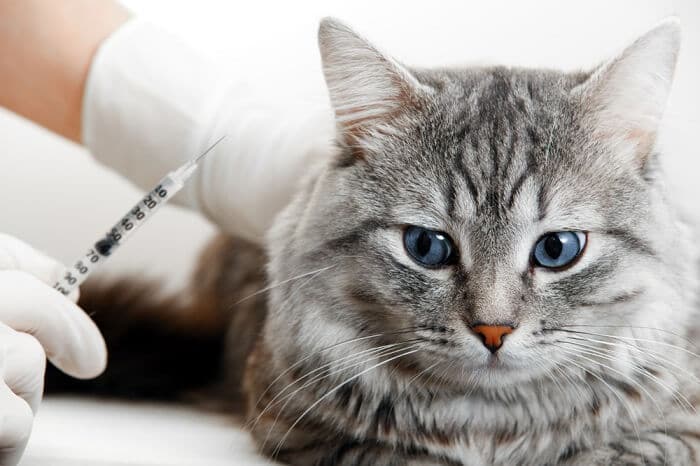
There are many risks associated with continuing meloxicam in a cat beyond the single injectable dose that is typically given at a veterinary practice.
For these reasons, no dosages for meloxicam for cats can be provided here. All doses in the U.S. are considered extra-label and should only be provided through an attending veterinarian.
If you live in a country where meloxicam is approved for long-term use in cats, it is very important to follow your veterinarian’s instructions, as low dosing protocols have been described associated with those approvals. Sometimes, this involves only giving a dose once every two or three days.
If you live in the U.S., there are two important things to keep in mind. First, meloxicam is available and FDA-approved for use in dogs, meaning that some cat owners who also have a dog may have this drug at home. If you have this drug at home for your dog, it should never be given to your cat, especially not without discussing it with your veterinarian first. There are other drugs that can be considered for both inflammation and pain before use of meloxicam.
Also Read: Homeopathy For Cats: What You Need To Know
Second, it’s important to understand that it is not illegal to prescribe meloxicam to cats in the U.S. However, it is considered an off-label application of the drug to prescribe to a cat. Many drugs in veterinary medicine are prescribed this way. Prescribing a drug off-label requires that a veterinarian has been in close communication with a pet parent and has close knowledge of the cat patient, including a recent examination.
With these steps in place, meloxicam could be prescribed using a low-dose protocol as long as the risks and benefits have been discussed and the benefits appear to outweigh the risks. Some veterinarians may require a release form or similar document to be signed to document that these discussions took place, in the event that adverse effects are seen.
In Summary

Though meloxicam is a useful drug that targets ability pain and inflammation, in cats, there are significant safety concerns in its use beyond a single injectable dose.
Meloxicam is a very useful NSAID in terms of its ability to combat pain and inflammation. However, in cats, there are significant safety concerns in its use beyond a single injectable dose. In the U.S., continued oral administration of meloxicam is considered contraindicated, and the manufacturer of Metacam also warns against continued use.
There may be some situations where off-label use of meloxicam may be warranted in which case the lowest, least frequent dose that manages signs of illness should be used. It is on this basis that meloxicam does carry approvals for long-term use in some countries.
Drug Dosing Disclaimer: We are only able to provide doses for medications that are FDA approved for use in cats and only as the label guidelines dictate. For medications that are used off-label we can only provide guidelines and safety information for use. Safe and appropriate dosing for off-label medications can only be determined by a primary care veterinarian.
We encourage you to work with your veterinarian to determine if a particular medication is appropriate for your cat. Changing or adjusting a dose for your cat on your own without consulting with a veterinarian can carry risk. We do not encourage use of medications prescribed for human use in pets without first consulting with a primary care veterinarian.
Frequently Asked Questions
What does meloxicam do for cats?
As a nonsteroidal anti-inflammatory drug (NSAID), meloxicam has the ability to block signals of pain caused by inflammation in the body.
Meloxicam may commonly be used in cats as a single injection following a surgical procedure like a spay, neuter, or orthopedic (bone/joint) surgery where lots of inflammation and pain may be present.
Due to significant safety concerns, continued use of meloxicam beyond one day either with further injectable or oral doses of the medication is considered contraindicated in the United States, as well as by the manufacturer of the brand Metacam (meloxicam), Boehringer Ingelheim.
How much meloxicam do I give my cat?
Since 2010, the oral suspension of Metacam has carried the following warning:
Warning: Repeated use of meloxicam in cats has been associated with acute renal failure and death. Do not administer additional doses of injectable or oral meloxicam to cats.
Continued use of meloxicam beyond a single injectable dose is considered contraindicated by both the manufacturer and the Food and Drug Administration (FDA).
Oral meloxicam should not be given to cats because of the significant risk of gastrointestinal effects and kidney failure.
Meloxicam does carry approval for use in cats at very low doses in some countries. If you live in one of these countries, or if your veterinarian has prescribed meloxicam to your cat, it is very important to only seek advice on dosing from your attending vet.
If you have meloxicam at home for your dog, never give your cat a dose of this medication without first consulting with your veterinarian, who may have alternative recommendations.
When should I give my cat meloxicam?
In short, you should never give your cat meloxicam due to the significant safety concerns that exist for administering meloxicam for any length of time.
If you live in a country where meloxicam is approved for long-term use in cats, it is important to discuss any questions about when to give it with your veterinarian.
How long can a cat stay on meloxicam?
Safety for use of meloxicam in cats has been established for a single injectable dose, which is typically given at a veterinary practice on the day of a surgical procedure or other situation involving pain and inflammation where use of the injection is warranted.
Beyond that single dose, no truly safe dose for meloxicam for cats has been established, and since 2010, repeated use of meloxicam in cats has been considered contraindicated by the manufacturer.
There are some protocols at low doses that describe use for several days, however health concerns may still be seen even with low or infrequent doses, especially for cats with underlying kidney disease or dysfunction.
